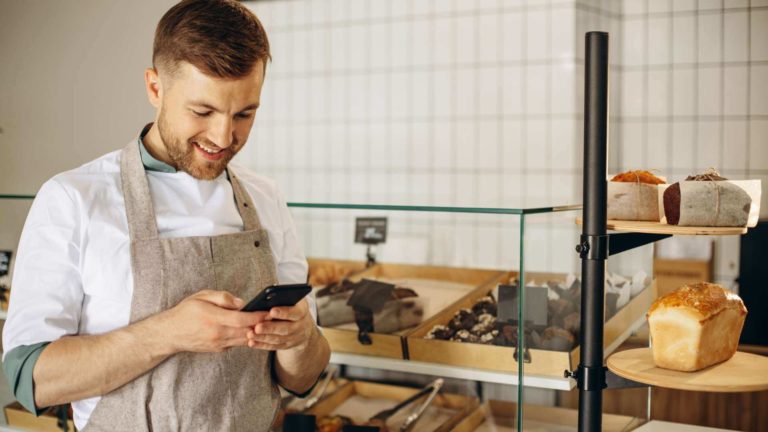Downward communication—also called top-down communication—is how managers share instructions, updates, and feedback with employees. This guide explains the benefits, drawbacks, and examples, plus strategies to use it effectively in your workplace.
Every goal, policy, or decision starts at the top. Downward communication ensures it reaches the people who need to act on it.
You see it everywhere: emails, team meetings, company-wide announcements. When the message is clear, operations run smoothly. When it’s not, confusion and inefficiency spread.
In this article, we break down what downward communication is, why it matters, and how you can use it to keep your workforce informed, connected, and moving in the right direction.
Key Takeaways
- Downward communication is a form of organizational communication, allowing for the transfer of tasks and information from higher levels to lower ones.
- It offers multiple benefits, such as improved efficiency and reliable delegation, but can be hindered by interpretative difficulties and lowered morale.
- Organizations must focus on clarity, feedback, and adaptability in order to overcome barriers in downward communication for successful implementation.
- Make use of digital communication tools like Connecteam to streamline your downward communication, engage employees, and improve workplace satisfaction.
What is Downward Communication
Downward communication is how leadership communicates direction to the rest of the team. It’s used to assign tasks, share policies, set expectations, and give feedback.
It’s a critical part of how any business runs. Without it, teams are left guessing. With it, roles are clear, goals are aligned, and decisions make it to the front lines where they actually matter.
It’s often formal, like announcements, handbooks, or training guides, but it can also show up in team meetings or direct feedback from a manager.
The Difference Between Down and Upward Communication
Downward communication pushes information down the chain of command. Upward communication flows the other way, giving employees a way to speak up, share feedback, and raise concerns.
Both are essential. Downward keeps things structured and on track. Upward gives leaders insight into what’s actually happening on the ground.
| Downward Communication | Upward Communication | |
|---|---|---|
| Direction | From leadership to employees | From employees to leadership |
| Purpose | Share instructions, policies, updates, and feedback | Provide feedback, raise concerns, share suggestions |
| Formality | More structured and often filtered | Less formal, can be spontaneous |
| Effect on Teams | Ensures consistency and alignment | Boosts engagement and morale when encouraged |
| Risks | Can feel authoritative, risk of distortion | Can be ignored if leaders don’t listen |
The key is balance. When employees feel heard and clearly guided, communication becomes a two-way street, and your culture gets stronger.
Types of Downward Communication Messages
Downward communication isn’t done just one way. Leaders share different kinds of messages depending on the situation. Let’s take a look at some of the most common types and why they matter:
Job Instructions
These are step-by-step guidelines that tell employees how to complete specific tasks. Clear instructions help people understand what’s expected and how their work fits into larger goals. This cuts down on confusion, saves time, and boosts productivity.

Policies and Procedures
This includes rules, company policies, and updates that impact daily operations. Sharing policies through downward communication ensures consistency, legal compliance, and a shared understanding of how things should be done. It also helps avoid mistakes and keeps everyone on the same page.
This Might Interest You
Learn more about how to implement Transparent Communication in the Workplace in our guide.
Performance Feedback
Managers use downward communication to give feedback, which can be constructive or celebratory. Regular feedback helps employees grow, stay motivated, and align with business goals.
Pro Tip
Make use of a dedicated employee management app like Connecteam to give your employees feedback and celebrate them publicly for a job well done. This makes people feel seen and will motive them to perform at their best.
Get started with Connecteam for free today!
Channels for Effective Downward Communication
The way you deliver your message matters just as much as the message itself. Choosing the right channel helps ensure the information lands clearly and is acted on. Here are a few key ways to make sure your message is heard loud and clear:
Face-to-Face Conversations
Personal, direct, and immediate. These are ideal for sensitive topics, real-time feedback, or complex instructions. You get body language, eye contact, and a chance to clarify things on the spot.
Written Communication
Emails, memos, and handbooks offer structure and clarity. They’re great when you need a permanent record or when information needs to be shared consistently across a team or location.
Did You Know?
Connecteam’s company knowledge base makes important information accessible and easy to find, so employees always know where to look when they need a procedure or policy refresher.
Communication platforms
Team apps, like Connecteam, make it easy for managers to send announcements, share updates, and assign schedules. With push notifications and built-in surveys, messages reach employees instantly, and there’s room for quick feedback when needed.
Because these tools are mobile-friendly, they’re ideal for keeping everyone informed if they’re on-site or in the field. For large or distributed teams, these platforms help standardize top-down communication and make sure nothing gets missed.
Downward Communication Examples
It’s easier to understand downward communication when you see it in action. Here are some everyday examples of how leaders pass information to employees:
- Policy updates: A CEO announces new hybrid work guidelines in a company-wide email.
- Task assignments: A manager gives step-by-step instructions to a field team on how to complete a safety inspection.
- Performance reviews: An employee receives quarterly feedback from their supervisor with goals for the next period.
- Company announcements: HR notifies all employees about a new benefits package through the internal app.
- Training materials: A department head shares a handbook or onboarding guide with new hires.
- Operational directives: A shift supervisor tells staff about updated closing procedures during a morning huddle.
These examples show that downward communication isn’t limited to formal memos—it also includes everyday instructions, recognition, and updates that keep employees aligned with business goals.
| Formal Downward Communication | Informal Downward Communication |
|---|---|
| Company-wide email announcing new workplace policies | A quick reminder from a manager during a team huddle |
| Performance review meetings with documented feedback | On-the-spot praise for a job well done |
| Employee handbooks or training manuals shared at onboarding | Text message or chat update about a shift change |
| Official HR announcements about benefits or pay changes | Casual conversation between a supervisor and employee in the breakroom |
| Safety guidelines distributed in writing to all employees | Verbal safety reminders before a task begins |
Benefits of Downward Communication
When downward communication is done right, it keeps everyone aligned and focused. Leaders can clearly set goals, assign tasks, and ensure that expectations are understood across the team.
Here’s how strong top-down communication can benefit your business:
- Improve delegation: Clear handoffs reduce confusion and rework.
- Boost efficiency: Everyone knows what needs to be done and when.
- Reinforce structure: Policies, procedures, and expectations are consistently shared.
- Create consistency: Teams across locations or departments stay aligned with company values and practices.
Downward communication can build a stronger connection between leadership decisions and daily operations, and gives employees a clear sense of direction.
Advantages vs. Disadvantages of Downward Communication
Downward communication has clear advantages. It improves efficiency by giving employees specific instructions and expectations. It also strengthens consistency across locations or departments, since policies and procedures are communicated in a unified way. Leaders can delegate more effectively, and employees understand how their work connects to business goals.
But downward communication can also create challenges if not handled carefully. Overly top‑down messaging can feel authoritative and lower morale, especially if employees don’t have a way to respond. Messages can get distorted when passed through layers of management. And if communication is slow or inconsistent, teams may feel left in the dark.
Barriers and Strategies to Overcome Them
Like any communication style, downward communication can run into barriers. Common issues include:
- Message distortion: Instructions change as they move through multiple managers.
- Lack of timeliness: Delayed updates cause confusion or missed deadlines.
- One‑way delivery: Employees feel unheard when there’s no channel for feedback.
- Information overload: Too much detail at once can overwhelm staff.
To overcome these barriers, focus on four key strategies:
- Clarity and simplicity: Use straightforward, jargon‑free language. Break down complex tasks into digestible steps.
- Multiple channels: Reinforce important updates through more than one medium (e.g., face‑to‑face plus a follow‑up memo or team app).
- Encourage feedback: Invite questions or clarifications to prevent misinterpretation.
- Timely communication: Share updates as early as possible so employees can act on them right away.
When these strategies are in place, downward communication becomes a tool for alignment instead of a bottleneck.
Tips for Using Downward Communication Effectively
Want your messages to land clearly and drive action? Here are four simple best practices that make downward communication more effective:
Be Clear and Direct
Use plain language. Skip buzzwords. Be specific about what’s needed and why it matters.
Pro Tip
Write how you talk. If it sounds complicated when you read it out loud, simplify it.
Encourage Feedback
Leave space for questions or pushback. This keeps communication from feeling like a lecture and opens the door for clarity and trust.
Pick the Right Channel
Match your message to the situation. Use in-person updates for sensitive topics, written messages for policy changes, and digital tools for speed and reach.
Communicate Early and Often
Don’t wait. Share important updates in real time. Consistent communication builds momentum and helps prevent surprises.
The Bottom Line
Downward communication keeps teams informed, aligned, and on track. When messages are clear, timely, and open to feedback, employees know what’s expected and feel more connected to your business.
Improving communication from the top down can lead to stronger performance, better engagement, and a more unified team.
Using tools Connecteam can make it even easier, helping you share updates, assign tasks, and communicate with every employee, no matter where they work.
Transform your business by trying Connecteam for free today!
FAQs
A common example is when a manager sends a company‑wide email announcing a new policy or procedure. Other examples include performance reviews, employee handbooks, or a CEO announcing organizational changes like a merger.
It’s when information flows from leadership to employees—like instructions, policies, or updates. Put simply, it’s how managers tell their teams what needs to be done and why.
It creates clarity, reduces confusion, and ensures consistency across teams. Leaders can delegate tasks more effectively, align employees with company goals, and keep operations running smoothly.
If not handled well, it can feel one‑sided. Messages may be misinterpreted, lose accuracy as they pass through layers, or lower morale if employees feel unheard. This is why pairing it with upward communication (feedback from employees) is key.
It depends on the situation. Face‑to‑face conversations work best for sensitive or complex topics. Written communication—like emails and memos—provides clarity and a record. Digital tools such as Connecteam ensure fast, consistent communication across distributed teams.
Downward communication ensures employees understand company goals, policies, and expectations. Without it, teams may lack direction, leading to inefficiency and confusion. Strong downward communication keeps everyone aligned and focused.
Downward communication flows from managers to employees, usually for instructions, policies, or feedback. Upward communication flows from employees to managers, providing feedback, concerns, or suggestions. Both are essential for a healthy workplace culture.
Keep messages clear, concise, and timely. Use the right channels for the situation, encourage feedback, and avoid information overload. Tools like Connecteam can make it easy to standardize and streamline top‑down communication across teams.




![image of [Free eBook] Building an Effective Internal Communication Strategy](https://connecteam.com/wp-content/uploads/2020/07/Scene-4-768x512.png)